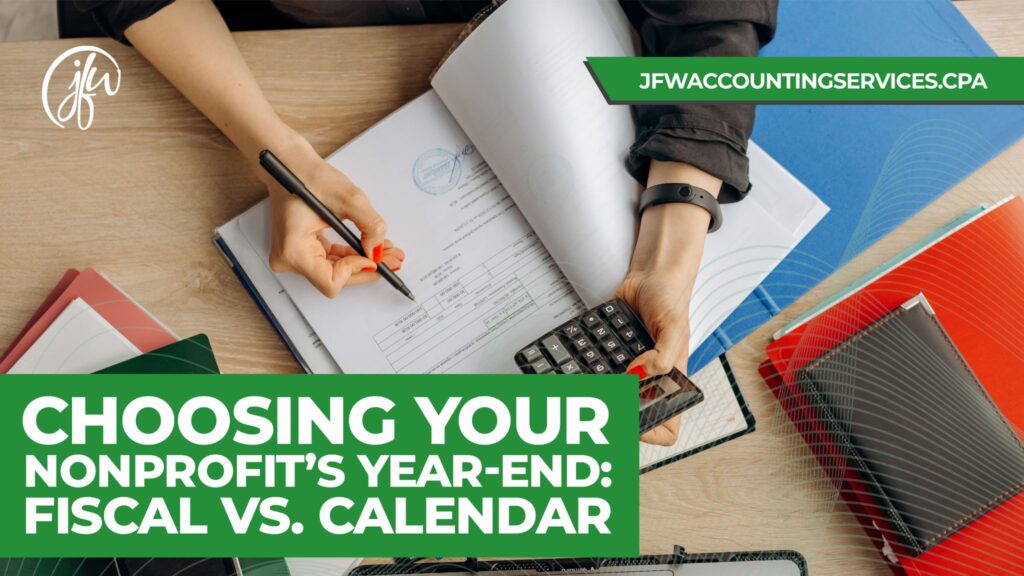Running a nonprofit organization is a rewarding process. But, just like any other business venture, there are decisions to be made that will affect the future operations of your entity. Choosing to use a calendar year or a fiscal year for accounting and bookkeeping purposes can impact your organization in more than one way.
In this article, we discuss the difference between the two tax years, special considerations for nonprofits, and how to change your selection.
Fiscal Year Vs Calendar Year
The IRS defines a tax year as “an annual accounting period for keeping records and reporting income and expenses.” Most folks understand that part but learning the difference and choosing the best option between a calendar year and a fiscal year can be tricky.
- Calendar year – The calendar year is 12 consecutive months that begin on January 1st and end on December 31st.
- Fiscal year – 12 consecutive months that begin on the first day of any month and end on the last day of the twelfth month.
- 52-53 week tax year – A fiscal tax year that does not have to end on the last day of a month and varies between 52 and 53 weeks.
The purpose of the tax year is to be used as a basis to calculate the amount of income you may owe taxes on. Businesses and nonprofit entities and business select their tax year when they file their first income tax return or Form 990. Any individual or business can use a calendar year, but if your organization meets any of the following criteria, you must use a calendar year:
- You have no financial books or records
- There is no defined annual accounting period.
- The current tax year doesn’t qualify as a fiscal year.
If you are not required by the IRS to use a calendar year and have already filed your first tax return, changing the tax year for your nonprofit is possible using the steps outlined later in this article.
Why Change Your Nonprofit Organization’s Tax Year?
The calendar year works well for many nonprofits. They wrap up the year on December 31st and hand their paperwork over to the accountant to prepare the annual informational return. Other organizations choose to use an April 30 fiscal year. The goal is to find what works best for your unique organization. Many nonprofits change their tax year from a calendar year to benefit grant tracking and donation streams, or to simplify budgeting.
6 Things To Consider About Your Nonprofit’s Year-End

Grant Cycles
Most nonprofits depend on grant revenue in some capacity. Grants often impose restrictions on revenue that include time periods. Consider some of the larger grants your organization depends on. Choosing a fiscal year based on those time periods may be the most effective way to manage those revenues.
Revenue Streams
A large portion of some nonprofit revenues comes from donations. Many organizations report the most donations in the fourth quarter of the calendar year. Donors give more in October, November, and December for different reasons which may include generosity, maximizing tax deductions, or tradition. Whatever the case, having a calendar year can make it difficult for a nonprofit to capture all revenue and close the books in time without significantly impacting net income.
Program Timing
Most nonprofit organizations run multiple programs or projects, but each of them has an “annual cycle.” It may be a good idea to align the tax year with the dominant program years so that specific projects are not being declared in more than one accounting year. An example may include an organization that does a lot of work providing donations during the Holiday months and may not want a tax year ending in December.
Combined Giving
If your organization receives revenue from Combined Giving Campaigns, you may want to consider that before deciding to change from a calendar year to a fiscal year since both the Federal campaign and local charitable giving campaigns require audit availability.
Charitable Registrations
Many states require that all charitable groups register. During that process, nonprofits are required to provide financial statements including a Form 990. Some states require that the organization provide a copy of tax-exempt status from the IRS and a formal audit report. Choosing a calendar year simplifies this paperwork. Changing the selection of the tax year complicates the process.
Audit Period And Presentation
Changing the selected tax year of a nonprofit affects the presentation of financial statements during the year the change was made and in the following 12 months. If an audit is required by the IRS, investors, Board policies, donors, or lending institutions, the nonprofit can choose to extend the audit period in the first year, auditing for more than 12 months. However, the auditor will be forced to present a single-year report with no comparable data available.
How To Make A Change
As previously stated, nonprofits do not need to do anything to select their first tax year other than file a return. However, if your organization has already adopted a calendar or fiscal year and you’d like to make a change you’ll need to submit Form 1128 to the IRS.
In addition to the IRS form, nonprofits that want to change their tax year are required to file a Short-Year Form 990 for the period prior to the switch. The words “Change of Accounting Period” must be written at the top of the form.
At JFW Accounting Services, we specialize in helping nonprofit organizations operate as efficiently as possible. Please contact us today if you have questions about your organization’s tax year or how to make the change.

Jo-Anne Williams Barnes, is a Certified Public Accountant (CPA) and Chartered Global Management Accountant (CGMA) holding a Master’s of Science in Accounting (MSA) and a Master’s in Business Administration (MBA). Additionally, she holds a Bachelor of Science (BS) in Accounting from the University of Baltimore and is a seasoned accounting professional with several years of experience in the field of managing financial records for non-profits, small, medium, and large businesses. Jo-Anne is a certified Sage Intacct Accounting and Implementation Specialist, a certified QuickBooks ProAdvisor, an AICPA Not-for-Profit Certificate II holder, and Standard for Excellence Licensed Consultant. Additionally, Jo-Anne is a member of American Institute of Certified Public Accountant (AICPA), Maryland Association of Certified Public Accountants (MACPA), and Greater Washington Society of Certified Public Accountants (GWSCPA) where she continues to keep abreast on the latest industry trends and changes.

